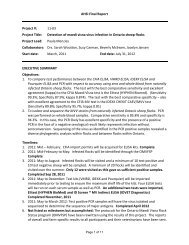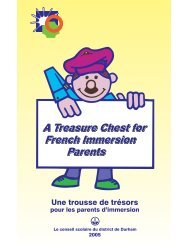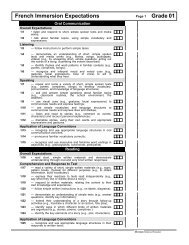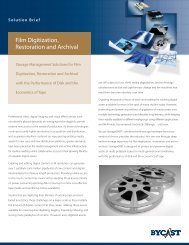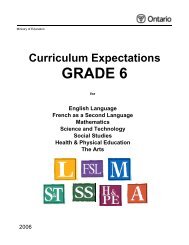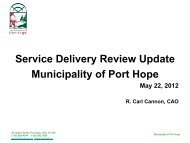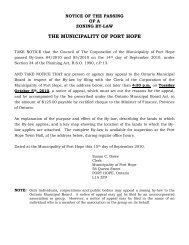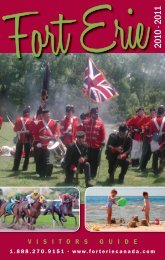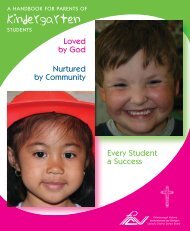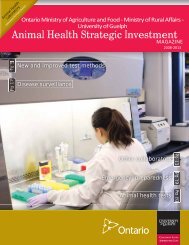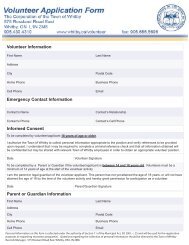GRADE 3 - PVNC Catholic District School Board
GRADE 3 - PVNC Catholic District School Board
GRADE 3 - PVNC Catholic District School Board
You also want an ePaper? Increase the reach of your titles
YUMPU automatically turns print PDFs into web optimized ePapers that Google loves.
Mathematics Expectations Page 3<br />
3m34<br />
– estimate, read (i.e., using a thermometer), and record positive<br />
temperatures to the nearest degree Celsius (i.e., using a number line; using<br />
appropriate notation) (Sample problem: Record the temperature outside<br />
each day using a thermometer, and compare your measurements with those<br />
reported in the daily news.);<br />
Grade 03<br />
3m35 – identify benchmarks for freezing, cold, cool, warm, hot, and boiling<br />
temperatures as they relate to water and for cold, cool, warm, and hot<br />
temperatures as they relate to air (e.g., water freezes at 0°C; the air<br />
temperature on a warm day is about 20°C, but water at 20°C feels cool);<br />
3m36 – estimate, measure, and record the perimeter of two-dimensional shapes,<br />
through investigation using standard units (Sample problem: Estimate,<br />
measure, and record the perimeter of your notebook.);<br />
3m37 – estimate, measure (i.e., using centimetre grid paper, arrays), and record<br />
area (e.g., if a row of 10 connecting cubes is approximately the width of a<br />
book, skip counting down the cover of the book with the row of cubes [i.e.,<br />
counting 10, 20, 30, ...] is one way to determine the area of the book cover);<br />
3m38 – choose benchmarks for a kilogram and a litre to help them perform<br />
measurement tasks;<br />
3m39 – estimate, measure, and record the mass of objects (e.g., can of apple<br />
juice, bag of oranges, bag of sand), using the standard unit of the kilogram<br />
or parts of a kilogram (e.g., half, quarter);<br />
3m40 – estimate, measure, and record the capacity of containers (e.g., juice can,<br />
milk bag), using the standard unit of the litre or parts of a litre (e.g., half,<br />
quarter).<br />
Measurement Relationships<br />
3m41 – compare standard units of length (i.e., centimetre, metre, kilometre) (e.g.,<br />
centimetres are smaller than metres), and select and justify the most<br />
appropriate standard unit to measure length;<br />
3m42 – compare and order objects on the basis of linear measurements in<br />
centimetres and/or metres (e.g., compare a 3 cm object with a 5 cm object;<br />
compare a 50 cm object with a 1 m object) in problem-solving contexts;<br />
3m43 – compare and order various shapes by area, using congruent shapes (e.g.,<br />
from a set of pattern blocks or Power Polygons) and grid paper for<br />
measuring (Sample problem: Does the order of the shapes change when<br />
you change the size of the pattern blocks you measure with?);<br />
3m44 – describe, through investigation using grid paper, the relationship between<br />
the size of a unit of area and the number of units needed to cover a surface<br />
(Sample problem: What is the difference between the numbers of squares<br />
needed to cover the front of a book, using centimetre grid paper and using<br />
two-centimetre grid paper?);<br />
3m45 – compare and order a collection of objects, using standard units of mass<br />
(i.e., kilogram) and/or capacity (i.e., litre);<br />
3m46<br />
– solve problems involving the relationships between minutes and hours,<br />
hours and days, days and weeks, and weeks and years, using a variety of<br />
tools (e.g., clocks, calendars, calculators).<br />
Geometry and Spatial Sense<br />
Overall Expectations<br />
3m47 • compare two-dimensional shapes and three-dimensional figures and sort<br />
them by their geometric properties;<br />
3m48 • describe relationships between two-dimensional shapes, and between<br />
two-dimensional shapes and three-dimensional figures;<br />
3m49 • identify and describe the locations and movements of shapes and objects.<br />
Geometric Properties<br />
3m50 – use a reference tool (e.g., paper corner, pattern block, carpenter's square)<br />
to identify right angles and to describe angles as greater than, equal to, or<br />
less than a right angle (Sample problem: Which pattern blocks have angles<br />
bigger than a right angle?);<br />
Ministry of Education



